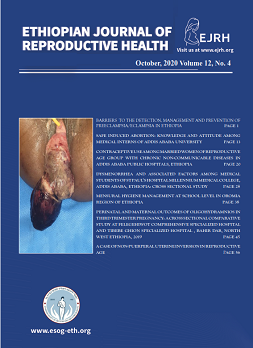ASSESSMENT OF DYSMENORRHEA AND ITS ASSOCIATED FACTORS AMONG FEMALE MEDICAL STUDENTS OF ST. PAUL’S HOSPITAL MILLENNIUM MEDICAL COLLEGE, ADDIS ABABA, ETHIOPIA: AN INSTITUTION BASED CROSS SECTIONAL STUDY
DOI:
https://doi.org/10.69614/ejrh.v12i4.419Abstract
Background: Dysmenorrhea is one of the most common gynecologic complaints in young women who present to clinicians. It is a health burden for most women and key public health problem in the world. Dysmenorrhea affects the quality of life and daily activities of females in school. Despite the presence of different studies that assess its prevalence and associated factor among women in Ethiopia, there is sparse information in relation to medical students. This study tries to assess dysmenorrhea, its effects and associated factors among female medical students.
Method: An institution-based cross-sectional study was employed to assess the prevalence of dysmenorrhea and its associated factors among female medical students of St Paul’s hospital millennium medical college. Using a single population formula with prevalence of 77.6%, 95% confidence level, ± 5% precision and 80% power for factors associated, sample size of 156 was calculated. With a simple random sampling data was collected with a pretested self-administered questioner. Data was entered and analyzed using SPSS version 23.0. Bivariate and Multivariable logistic regression was done and a P<0.05 was taken as statistically significant.
Results: A total of 156 female medical students were included in the survey. The prevalence of dysmenorrhea was 79.5%. About one third (33.3%) of the participants reported that they have a family history of dysmenorrhea and experienced moderate type of pain (39.7%). Back pain (64.1%), Weakness (40.4%) and Loss of appetite (32.7%) are amongst the commonest symptoms associated with dysmenorrhea. More than half of the participants reported to be irritable (54.6%) and having decreased academic performance (50.6%). Students also reported having lack of concentration (42.9%) and poor appetite (41.7%). More than half of the respondents (58.3%) use home remedies as a primary management option. Heat (41%) and tea (41.7%) were the most used home remedies. More than half of the respondents (55.8%) reported to use over the counter drugs such as Ibuprofen and diclofenac. Alcohol consumption (AOR 95 % (CI) = 8.38 (1.078, 65.18), p=0.042) and longer menstrual cycle (AOR 95% (CI) =8.48 (1.087, 66.19), p=0.041) had statistically significant association with the occurrence of dysmenorrhea.
Conclusion: The present study revealed that high proportion of female medical students experience dysmenorrhea. Decrease in academic performance was found to be the most common impact of dysmenorrhea. The majority of respondents used home remedies and over the counter medications for treatment. It is recommended to give due attention to female medical students and addressing their reproductive needs in relation to management of dysmenorrhea. Educating on effective management of dysmenorrhea with lifestyle modifications, seeking medical help and appropriate use of over the counter drugs is also recommended.
Key words: Dysmenorrhea, menstrual cycle, over the counter drugs



